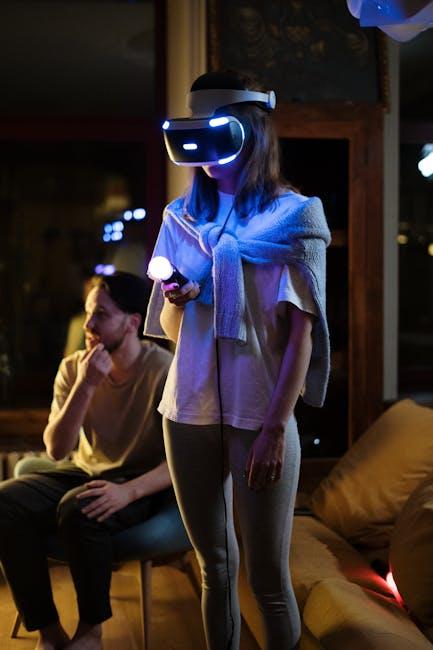In the ever-evolving landscape of television production, where the line between reality and imagination blurs, “The Mandalorian” emerged as a groundbreaking force. With its seamless blend of cutting-edge technology and storytelling, this series redefined the boundaries of what’s possible on the small screen. At the heart of this revolution lies the innovative use of virtual sets, a technique that not only transformed the visual experience but also reshaped the very fabric of TV production. Join us as we delve into how “The Mandalorian” harnessed the power of virtual sets to craft a new frontier in television, merging the magic of cinema with the intimacy of episodic storytelling.
Revolutionizing Filmmaking with Virtual Reality Environments
The groundbreaking approach taken by The Mandalorian has set a new standard in the industry, embracing virtual reality environments to redefine the possibilities of television production. By utilizing the innovative technology of the StageCraft LED volume, the series managed to blend digital and physical elements seamlessly, creating a more immersive and flexible filming experience. This method allows filmmakers to project high-resolution images onto a massive curved LED screen, which acts as a dynamic backdrop that can adapt in real-time to camera movements. This not only enhances the visual storytelling but also provides actors with a tangible environment to interact with, bridging the gap between imagination and reality.
Key benefits of this virtual set technology include:
- Cost Efficiency: Reducing the need for extensive location shoots and physical set constructions.
- Creative Freedom: Offering directors and cinematographers the ability to experiment with limitless worlds and scenarios.
- Time-Saving: Streamlining production schedules by minimizing setup and teardown times.
As this technology continues to evolve, it promises to inspire a new wave of creativity, pushing the boundaries of what can be achieved on screen.

The Role of LED Technology in Crafting Immersive Worlds
In the groundbreaking production of The Mandalorian, LED technology has redefined the boundaries of television storytelling by creating breathtakingly immersive environments. The innovative use of LED screens allowed filmmakers to construct expansive virtual sets that enveloped actors in dynamic, interactive landscapes. This approach not only enhanced the visual realism but also offered directors the flexibility to adjust lighting and scenery in real-time, resulting in seamless integration between the physical and digital worlds.
- Dynamic Lighting: LED screens provided naturalistic lighting that matched the virtual backgrounds, eliminating the need for extensive post-production adjustments.
- Real-time Rendering: Advanced graphics engines enabled the rendering of intricate backgrounds in real-time, offering directors and actors immediate feedback on set.
- Cost Efficiency: By reducing the reliance on location shoots and green screens, productions saved both time and resources.
Through these advancements, LED technology has not only transformed the way stories are told but also paved the way for a new era of creative possibilities in television production.
Behind the Scenes: Integrating Digital and Physical Elements
In the groundbreaking production of “The Mandalorian,” the seamless blend of digital and physical elements redefined the television landscape. This was achieved through the innovative use of StageCraft, a virtual production technology that integrates LED screens to create immersive environments. These LED walls project high-resolution backgrounds, allowing actors to interact with their surroundings in real-time. This not only enhances performance authenticity but also provides directors with unprecedented control over lighting and perspective.
- Real-time Rendering: The technology leverages powerful game engines to render scenes instantaneously, allowing for dynamic adjustments during shoots.
- Cost Efficiency: By minimizing the need for on-location shoots, production costs are significantly reduced, while maintaining high-quality visuals.
- Environmental Impact: With fewer sets to construct and transport, the carbon footprint of the production is notably decreased.
These advancements demonstrate a pivotal shift in how stories can be brought to life, offering a glimpse into the future of filmmaking where the line between digital and physical continues to blur.

Lessons for Future Productions: Embracing Virtual Set Innovation
In the wake of The Mandalorian’s groundbreaking use of virtual sets, future productions are poised to embrace a host of innovative techniques that redefine traditional filming landscapes. Virtual sets, primarily through the use of LED screens and real-time rendering, have proven to be more than just a technological novelty. They offer a seamless blend of digital and physical environments, enabling filmmakers to create expansive worlds without leaving the studio.
- Flexibility and Control: Directors can manipulate lighting, weather, and time of day instantaneously, allowing for greater creative control and consistency.
- Cost Efficiency: While the initial setup might seem costly, virtual sets reduce the need for location scouting, travel, and elaborate physical sets.
- Environmental Impact: Reducing the carbon footprint of productions, these innovations help align the entertainment industry with sustainable practices.
By integrating these virtual set technologies, productions can not only streamline their processes but also unlock new creative potentials, making once-impossible scenes a vivid reality.

